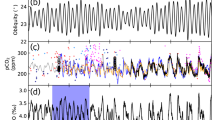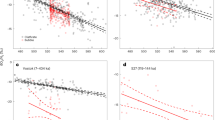Abstract
Palaeomagnetic data suggest that the Earth was glaciated at low latitudes during the Palaeoproterozoic1,2 (about 2.4–2.2 Gyr ago) and Neoproterozoic3,4,5,6,7,8 (about 820–550 Myr ago) eras, although some of the Neoproterozoic data are disputed9,10. If the Earth's magnetic field was aligned more or less with its spin axis, as it is today, then either the polar ice caps must have extended well down into the tropics — the ‘snowball Earth’ hypothesis8 — or the present zonation of climate with respect to latitude must have been reversed. Williams11 has suggested that the Earth's obliquity may have been greater than 54° during most of its history, which would have made the Equator the coldest part of the planet12. But this would require a mechanism to bring the obliquity down to its present value of 23.5°. Here we propose that obliquity–oblateness feedback13 could have reduced the Earth's obliquity by tens of degrees in less than 100 Myr if the continents were situated so as to promote the formation of large polar ice sheets. A high obliquity for the early Earth may also provide a natural explanation for the present inclination of the lunar orbit with respect to the ecliptic (5°), which is otherwise difficult to explain.
This is a preview of subscription content, access via your institution
Access options
Subscribe to this journal
Receive 51 print issues and online access
$199.00 per year
only $3.90 per issue
Buy this article
- Purchase on Springer Link
- Instant access to full article PDF
Prices may be subject to local taxes which are calculated during checkout



Similar content being viewed by others
References
Evans, D. A., Beukes, N. J. & Kirschvink, J. L. Low-latitude glaciation in the Palaeopropterozoic era. Nature 386, 262–266 (1997).
Williams, G. E. Schmidt, P. W. Paleomagnetism of the Palaeoproterozoic Gowganda and Lorrain formations, Ontario: low paleolatitude for Huronian glaciation. Earth Planet. Sci. Lett. 153, 157–169 (1997).
Frakes, L. A. Climates Throughout Geologic Time (Elsevier, Amsterdam, (1979)).
Embleton, B. J. & Williams, G. E. Low paleolatitude of deposition for late Precambrian periglacial varvites in South Australia: implications for palaeoclimatology. Earth Planet. Sci. Lett. 79, 419–430 (1986).
Zhang, H. & Zhang, W. Palaeomagnetic data, late Precambrian magnetostratigraphy, and tectonic evolution of eastern China. Precambr. Res. 29, 65–75 (1985).
Schmidt, P. W. & Williams, G. E. The Neoproterozoic climatic paradox: Equatorial paleolatitude for Marinoan glaciation near sea level in South Australia. Earth Planet. Sci. Lett. 134, 107–124 (1995).
Park, J. K. Paleomagnetic evidence for low-latitude glaciation during deposition of the Neoproterozoic Rapitan Group, Mackenzie Mountains, N.W.T., Canada. Can. J. Earth Sci. 34, 34–49 (1997).
Hoffman, P. F., Kaufman, A. J., Halverson, G. P. & Schrag, D. P. ANeoproterozoic snowball Earth. Science 281, 1342–1346 ((1998)).
Meert, J. G. & Van der Voo, R. The Neoproterozoic (1000-540 Ma) glacial intervals: No more snowball earth? Earth Planet. Sci. Lett. 123, 1–13 (1994).
Williams, G. E., Schmidt, P. W., Embleton, B. J., Meert, J. G. & Van der Voo, R. The Neoproterozoic (1000-540 Ma) glacial intervals; no more snowball earth?; discussion and reply. Earth Planet. Sci. Lett. 131, 115–125 (1995).
Williams, G. E. History of the Earth's obliquity. Earth Sci. Rev. 34, 1–45 (1993).
Ward, W. R. Climatic variations on Mars: I. Astronomical theory of insolation. J. Geophys. Res. 79, 3375–3386 (1974).
Rubincam, D. P. The obliquity of Mars and “climate friction”. J. Geophys. Res. 98, 10827–10832 (1993).
Crowley, T. J. & Baum, S. K. Effect of decreased solar luminosity on Late Precambrian ice extent. J. Geophys. Res. 98, 16723–16732 (1993).
Caldeira, K. & Kasting, J. F. Susceptibility of the early Earth to irreversible glaciation caused by carbon dioxide clouds. Nature 359, 226–228 (1992).
Vanyo, J. P. & Awramik, S. M. Length of day and obliquity of the ecliptic 850 Ma ago — preliminary results of a stromatolite growth model. Geophys. Res. Lett. 9, 1125–1128 (1982).
Awramik, S. M. & Vanyo, J. P. Heliotropism in modern stromatolites. Science 231, 1279–1281 (1986).
Rochester, M. G. The secular decrease of obliquity due to dissipative core-mantle coupling. Geophys. J. R. Astron. Soc. 46, 109–126 (1976).
Bills, B. G. Obliquity-oblateness feedback: Are climatically sensitive values of obliquity dynamically unstable? Geophys. Res. Lett. 21, 177–180 (1994).
Rubincam, D. P. Has climate changed Earth's tilt? Paleoceanography 10, 365–372 (1995).
Peltier, W. R. & Jiang, X. Precession constant of the Earth: Variations through the ice-age. Geophys. Res. Lett. 21, 2299–2302 (1994).
Ito, T., Masuda, K., Hamano, Y. & Matsui, T. Climate friction: A possible cause for secular drift of Earth's obliquity. J. Geophys. Res. 100, 15147–15161 (1995).
Williams, D. M. The Stability of Habitable Planetary Environments.Thesis. Pennsylvania State Univ.((1998)).
Hecht, J. & Scotese, C. R. Ages of the Earth (MacMillan, New York, (1997)).
Imbrie, J. et al. On the structure and origin of major glaciation cycles: 1. linear responses to Milankovitch forcing. Paleoceanography 7, 701–738 (1992).
Levison, H. F. & Duncan, M. J. The long-term dynamical behavior of short-period comets. Icarus 108, 18–36 (1994).
Laskar, J., Joutel, F. & Robutel, P. Orbital, precessional, and insolation quantities for the Earth from −20 Myr to +10 Myr. Astron. Astrophys. 270, 522–533 (1993).
Goldreich, P. History of the lunar orbit. Rev. Geophys. 4, 411–439 (1966).
Touma, J. & Wisdom, J. Evolution of the Earth-Moon system. Astron. J. 108, 1943–1961 (1994).
Ida, S., Canup, R. M. & Stewart, G. R. Lunar accretion from an impact-generated disk. Nature 389, 353–357 (1997).
Rubincam, D. P. Tidal friction and the early history of the Moon's orbit. J. Geophys. Res. 80, 1537–1548 (1975).
Touma, J. & Wisdom, J. Resonances in the early evolution of the Earth-Moon system. Astron. J. 115, 1653–1663 (1998).
Walker, J. C. G. & Zahnle, K. J. Lunar nodal tide and the distance to the Moon during the Precambrian. Nature 320, 600–602 (1986).
Peltier, W. R. Ice age paleotopography. Science 265, 195–201 (1994).
Acknowledgements
We thank H. Levison and M. Duncan for the orbital integration code (SWIFT) and J. Laskar for the code used to integrate the precession equations. We also acknowledge discussions with J.Melosh and R. Canup concerning the lunar inclination. D.M.W. was supported by a NASA graduate student research fellowship awarded in 1995, and J.F.K. was supported by the NASA Exobiology Program.
Author information
Authors and Affiliations
Corresponding author
Rights and permissions
About this article
Cite this article
Williams, D., Kasting, J. & Frakes, L. Low-latitude glaciation and rapid changes in the Earth's obliquity explained by obliquity–oblateness feedback. Nature 396, 453–455 (1998). https://doi.org/10.1038/24845
Received:
Accepted:
Issue Date:
DOI: https://doi.org/10.1038/24845
This article is cited by
-
δ18O and SST signal decomposition and dynamic of the Pliocene-Pleistocene climate system: new insights on orbital nonlinear behavior vs. long-term trend
Progress in Earth and Planetary Science (2018)
-
Climates of the Earth and Cryosphere Evolution
Surveys in Geophysics (2011)
-
Sedimentary challenge to Snowball Earth
Nature Geoscience (2008)
-
Proterozoic low orbital obliquity and axial-dipolar geomagnetic field from evaporite palaeolatitudes
Nature (2006)
Comments
By submitting a comment you agree to abide by our Terms and Community Guidelines. If you find something abusive or that does not comply with our terms or guidelines please flag it as inappropriate.



